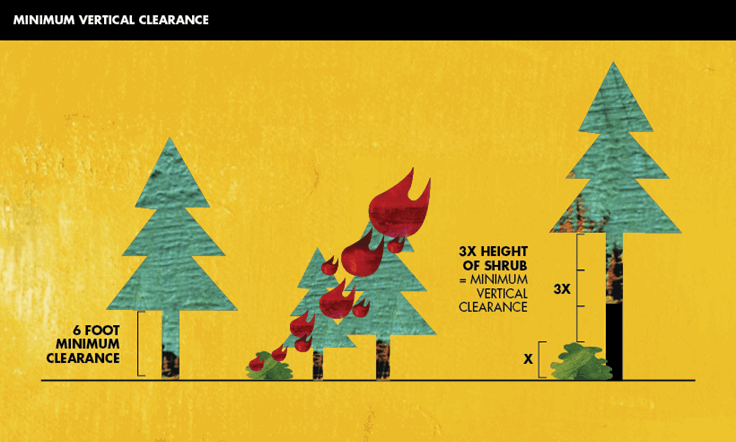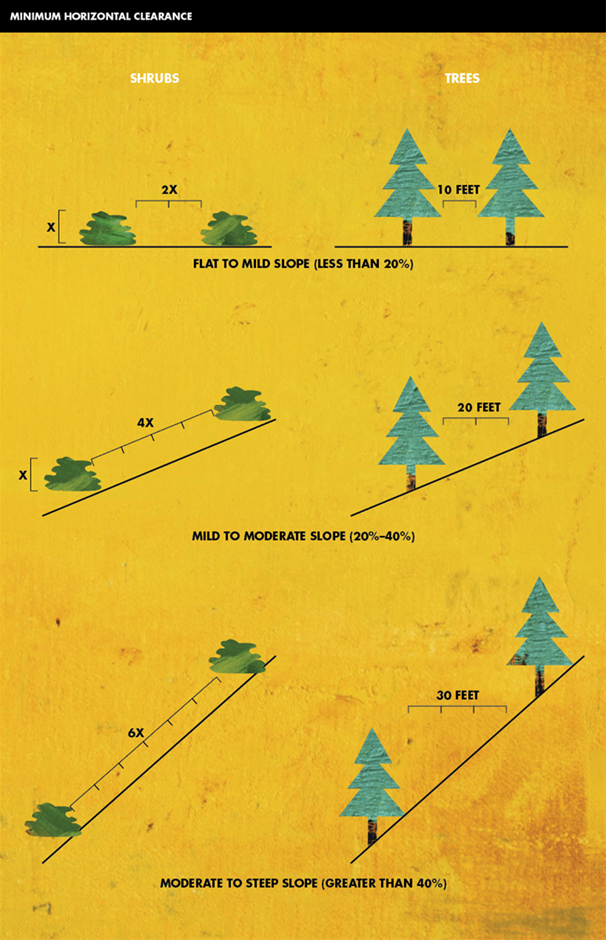Defensible Space
Practical ways to protect your home from wildfire.
Defensible Space
Defensible space is the buffer between your structure and the surrounding area.
Adequate defensible space acts as a barrier to slow or halt the progress of fire that would otherwise engulf your property. It also helps ensure the safety of firefighters defending your home. Defensible space is the first line of defense for your home against wildfire.
The intensity of wildfire fuel management varies within the 100-foot perimeter of the home, with more intense fuels’ reduction occurring closer to your home. Start at the home and work your way out to 100 feet or to your property line, whichever is closer. Learn more about the Defensible Space Zones below.
California has diverse regional climates, and some local government agencies have stricter standards that the State’s minimum requirements. For example, San Diego County requires 50 feet of clearance in Zone 1. Check with your local fire department or fire protection district for defensible space or weed abatement requirements.
If you reside in the following counties, please visit:
Defensible Space Zones
The first five feet from your home is the most important. Keeping the area closest to buildings, structures, and decks clear will prevent embers from igniting materials that can spread the fire to your home.
Why? The majority of homes lost to wildfire are ignited by flying embers. Embers can travel miles ahead of the active front of wildfires.
What to do:
- Use hardscape like gravel, pavers, or concrete. No combustible bark or mulch.
- Remove all dead and dying plants, weeds, and debris (leaves, needles, etc.) from your roof, gutter, deck, porch, stairways, and under any areas of your home.
- Remove all branches within 10 feet of any chimney or stovepipe outlet.
- Limit combustible items (like outdoor furniture and planters) on top of decks.
- Relocate firewood and lumber to Zone 2.
- Replace combustible fencing, gates, and arbors attached to the home with noncombustible alternatives.
- Consider relocating garbage and recycling containers outside this zone.
Regularly clear dead or dry vegetation and create space between trees. During times of drought when watering is limited, pay special attention to clearing dead or dying material.
Why? Removing dead plants and creating space between trees and shrubs creates a buffer for your property and reduces potential fuel for fire.
What to do:
- Remove all dead plants, grass, and weeds.
- Remove dead or dry leaves and pine needles.
- Trim trees regularly to keep branches a minimum of 10 feet from other trees.
Continue reducing potential fuel within 100 feet or the property line.
Why? 100 feet of defensible space is required by law. Public Resources Code (PRC) 4291
What to do:
- Cut or mow annual grass down to a maximum height of four inches.
- Create horizontal space between shrubs and trees. (See diagram)
- Create vertical space between grass, shrubs and trees. (See diagram)
- Remove fallen leaves, needles, twigs, bark, cones, and small branches. However, they may be permitted to a depth of three inches.
- Keep 10 feet of clearance around exposed wood piles, down to bare mineral soil, in all directions.
- Clear areas around outbuildings and propane tanks. Keep 10 feet of clearance to bare mineral soil and no flammable vegetation for an additional 10 feet around their exterior.
How to Space Trees and Shrubs
Maintain space between the lowest tree branches and the ground or shrubs.
- Remove all tree branches at least six feet from the ground.
- Allow extra vertical space between shrubs and trees. Lack of vertical space can allow a fire to move from the ground to the brush to the treetops like a ladder. This leads to more intense fire closer to your home.
- Keep at least three times the height of any shrubs between the shrubs and the lowest branches of trees.
- Example: A 5-foot shrub is growing near a tree. 15 feet of clearance is needed between the top of the shrub and the lowest tree branch.

How much space should you leave between trees or shrubs?
Horizontal space depends on the slope of the land and the height of the shrubs or trees. Leave more space between vegetation on bigger slopes. Refer to the chart below to determine spacing distance.

Space between shrubs:
- Flat or mild slope (less than 20%): Two times the height of the shrub.
- Mild to moderate slope (20-40%): Four times the height of the shrub
- Moderate to steep slope (greater than 40%): Six times the height of the shrub
Space between trees:
- Flat or mild slope (less than 20%): 10 feet.
- Mild to moderate slope (20-40%): 20 feet.
- Moderate to steep slope (greater than 40%): 30 feet.
Use our self-assessment tool to see how prepared your property is for wildfire.
Make a personalized plan to prepare for wildfire.
Take an interactive look through our Wildfire Action Plan.
The Model Defensible Space Inspection platform was created to enable local jurisdictions to build their own defensible space program. Examples of local government agencies that may apply:
Multi-Function District, Fire Protection District, City Fire Department, County Code Enforcement
- Mow before 10 a.m. and never on a hot or windy day.
- String trimmers are safer than lawnmowers for clearing vegetation.
- When watering less during times of drought, be sure to remove all dead or dying vegetation.